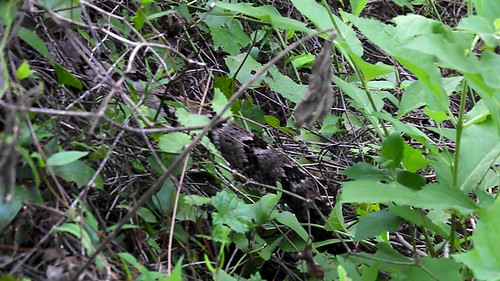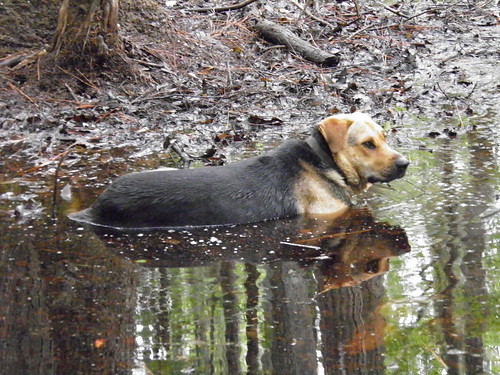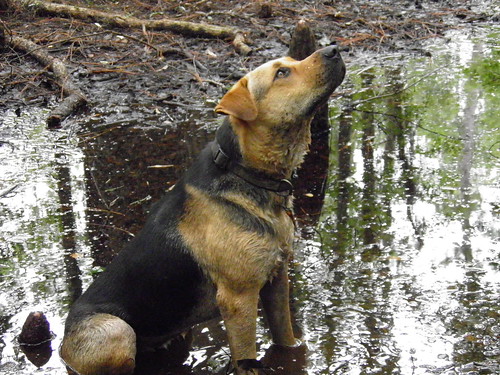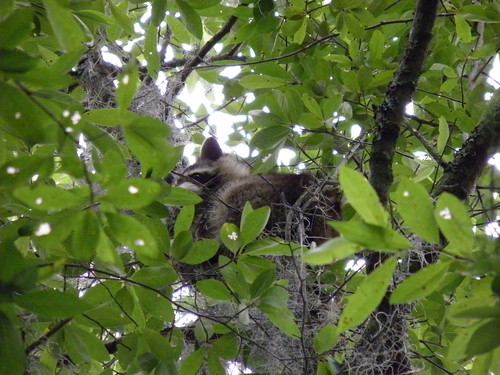Why yes, there are snakes. This timber rattler was crawling into the vines: Continue reading
Tag Archives: Georgia
Dogs in swamp
To wade around in with her sister: Continue reading
Pointing brown dog
I’ll just stand like a statue until you see it.
Yellow dog helps point. Continue reading
Yellow dog and raccoon
A raccoon. Yellow dog sees it, too: Continue reading
Brown dog tries to climb tree
Squirrel on Feeder
Birds in Fountain
Cover Crops to prevent erosion
 Sarah Uttech writes that
Cover crops reduce erosion, runoff:
Sarah Uttech writes that
Cover crops reduce erosion, runoff:
Cover crops may be more effective at reducing soil erosion and runoff after maize harvest than rough tillage, according to scientists from the Université Catholique de Louvain, in collaboration with the Independent Center for the Promotion of Forage (CIPF).This study was done in Belgium, but Tifton A soil we have around here is a sandy loamy soil. And as we know from research done in Georgia, around here we also need to manage the mutant pigweed, and for that a combination of plowing and winter cover crops works best.The three-year study, supervised by Charles Bielders and conducted by Eric Laloy, measured erosion and runoff losses from silt loam and sandy loam soils in continuous silage maize cropping. The research revealed that cover crops reduced erosion by more than 94% compared to bare soil during the intercropping period. Cover crops and reduced tillage appeared equally effective in reducing runoff and soil loss between cropping cycles, despite the fact that the cover crop development was very poor.
The results were reported in the May/June 2010 edition of the Journal of Environmental Quality, a publication of the American Society of Agronomy, Crop Science Society of America, and Soil Science Society of America.
-jsq
Managing the Seedbank by Plowing
About pigweed, Georgia Extension weed scientist Dr. Stanley Culpepper says:
Economic survival will depend on managing the seedbank!!!!That’s on page 30 of a 46 page presentation at the 2010 Beltwide – Consultants Conference, after discussing how rapidly Roundup-Ready seeds have been adopted:
And how the value of advice on weed control during that period rapidly decreased as a direct correlation: Continue reading
Farmland for Food, Wildlife, Flood Control, Air Quality, and Agrotourism
 Gretchen found this one, too (think I can get her to blog?).
Judi Gerber writes about
Why Saving Farmland Is So Important:
Gretchen found this one, too (think I can get her to blog?).
Judi Gerber writes about
Why Saving Farmland Is So Important:
…without local farms, there’s no local food, or, as the American Farmland Trust (AFT) puts it: “No Farms, No Food.”.
And it’s not even just food:
Farmland is green space, even though most people don’t think of it that way. It is a significant contributor to environmental quality. As AFT states, “Farm and ranch lands provide food and cover for wildlife, help control flooding, protect wetlands and watersheds, and maintain air quality. They can absorb and filter wastewater and provide groundwater recharge. New energy crops even have the potential to replace fossil fuels.”
And there’s more:
Farmland provides fiscal stability to local governments and boosts the economy. It does this by contributing to a community’s infrastructure and helps a local economy through sales, job creation, and support services or businesses.There are some plans afoot about agrotourism in Lowndes County.One of the most unique of these support services is tourism, or more specifically, agri-tourism. There are plenty of places that people visit to see rural scenery or to enjoy the food or drink of a specific region including the wineries in California’s Napa Valley, or popular farm stays like those found in Italy, and increasingly, here in the United States.
-jsq







